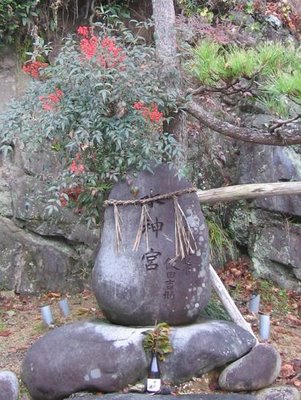 Daruma dances in the deep sea - what a sight !  |
Red paper lanterns, or aka-chochin, are a familiar sight on the city streets of Japan, where they typically hang at the entrances to cheap pubs, capturing the attention of passersby. The ocean, however, is home to a different variety of red paper lantern — an unusual species of deep-sea jellyfish.
Officially named Pandea rubra, the red paper lantern medusa (aka-chochin kurage) was first discovered in the Bering Sea in 1913, but details about its distribution and life cycle have long remained a mystery. In recent years, the creature has caught the eye of researchers at the Japan Agency for Marine-Earth Science and Technology (JAMSTEC) armed with high-definition video cameras.
Inside the transparent hood is a deep red colored mantle that can crumple up or expand like a paper lantern, hence the name. JAMSTEC researcher
Dr. Dhugal Lindsay is credited with coming up with the name.
Photo and Text source : pinktentacle.com
.................................................................................
te no hira no kurage ni chokumen suru medama
upon my palm
the jellyfish comes face to face
with eyeballs
source : Humour in Haijin Essay
Dhugal Lindsay, haijinx summer 2001
:::::::::::::::::::::::::::::::::::::::::::::::::::::::::::::::::::::::::::::::::::::::::::::::::::::
アカチョウチンクラゲ Akachochin jellyfish 赤提灯クラゲ
CLICK here for PHOTOS !
Dhugal J. Lindsay's Haiku Universe
I saw Dhugal in the haiku TV lesson of NHK,
where he introduced this amazing animal.
:::::::::::::::::::::::::::::::::::::::::::::::::::::::::::::::::::::::::::::::::::::::::::::::::::::

Akachochin and Daruma san
:::::::::::::::::::::::::::::::::::::::::::::::::::::::::::::::::::::::::::::::::::::::::::::::::::
:::::::::::::::::::::::::::::::::::::::::::::::::::::::::::::::::::::::::::::::::::::::::::::::::::
kigo for all summer
kurage 水母 (くらげ / クラゲ) jellyfish, Qualle, Meduse
(lit. water mother)
kurage 海月(くらげ) lit. sea moon
Fam. Cubozoa and Scyphozoa
akakurage, aka kurage 赤水母(あかくらげ)red jellyfish
Chrysaora melanaster
. . . CLICK here for Photos !
Amakusa kurage 天草水母(あまくさくらげ)from Amakusa
Bizen kurage 備前水母(びぜんくらげ)from Bizen
Echizen kurage 越前水母(えちぜんくらげ)Echizen Jellyfish
andon kurage 行燈水母(あんどんくらげ)jellyfish like an andon lamp
Carybdea rastoni
. . . CLICK here for Photos !
hikurage 火水母(ひくらげ)"fire jellyfish"
Tamoya bursaria
murasaki kurage 紫水母(むらさきくらげ)purple jellyfish
ibo kurage 疣水母(いぼくらげ)"jellyfish with warts"
ebi kurage 蝦水母(えびくらげ)"jellyfish like a prawn"
Netrostoma setouchianum
. . . CLICK here for Photos !
tako kurage 蛸水母(たこくれげ)"jellyfish like an ocotpus"
. . . CLICK here for Photos !
yuurei kurage 幽霊水母(ゆうれいくらげ)"jellyfish like a ghost"
. . . CLICK here for Photos !
kigo for summer in Australia
moon jelly
http://en.wikipedia.org/wiki/Moon_jelly
:::::::::::::::::::::::::::::::::::::::::::::::::::::::::::::::::::::::::::::::::::::::::::::::::::
kigo for early autumn
katsuo no eboshi 鰹の烏帽子 (かつおのえぼし)
denki kurage 電気くらげ(でんきくらげ) "electric jellyfish"
Portuguese man-of-war
Physalia physalis utriculus
. . . CLICK here for Photos !
Portugiesische Galeere
:::::::::::::::::::::::::::::::::::::::::::::::::::::::::::::::::::::::::::::::::::::::::::::::::::::
沈みゆく海月みづいろとなりて消ゆ
shizumiyuku kurage mizu-iro to narite kiyu
sinking down
the jellyfish becomes blue
and disappears
Yamaguchi Seison 山口青邨
:::::::::::::::::::::::::::::::::::::::::::::::::::::::::::::::::::::::::::::::::::::::::::::::::::::
Along the sea of Ariakekai during the summer months, fishermen go after the Red Jellyfish. It is often eaten sliced and raw as sashimi, with a bit of grated ginger and soy sauce, even as a kind of raw "soomen".
nama kurage 生クラゲ raw jelly fish
. . . CLICK here for Photos !
Other types of jellyfish are usually salted and dried.
shio kurage, shiokurage 塩くらげ salted jelly fish
. . . CLICK here for Photos !
. WASHOKU
The Ariake Sea (有明海, Ariake-kai)
:::::::::::::::::::::::::::::::::::::::::::::::::::::::::::::::::::::::::::::::::::::::::::::::::::::
[ . BACK to WORLDKIGO TOP . ]
[ . BACK to DARUMA MUSEUM TOP . ]
:::::::::::::::::::::::::::::::::::::::::::::::::::::::::::::::::::::::::::::::::::::::::::::::::::::




























